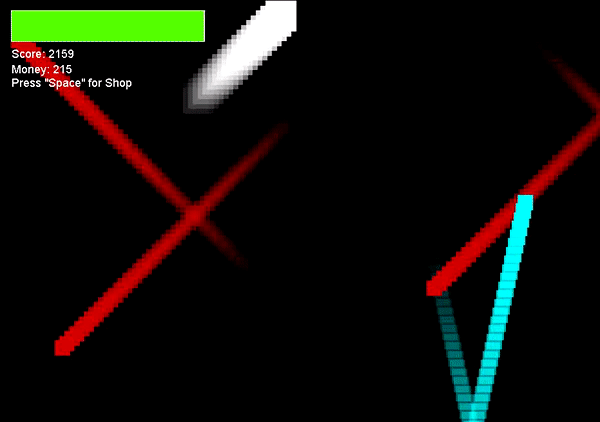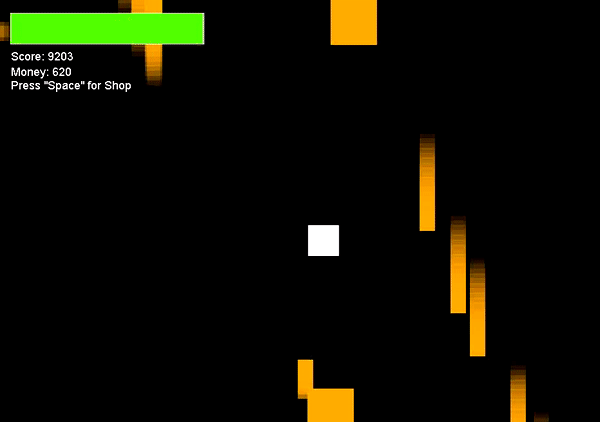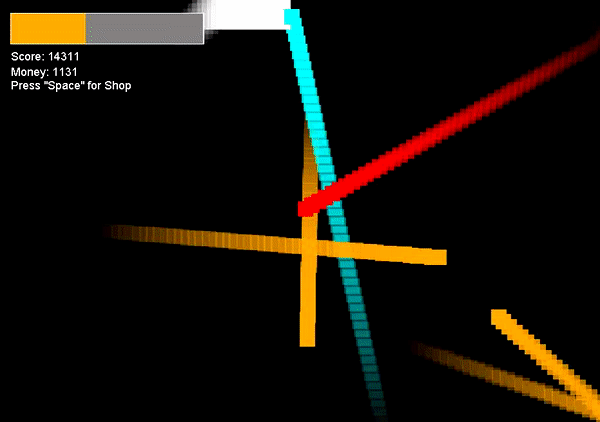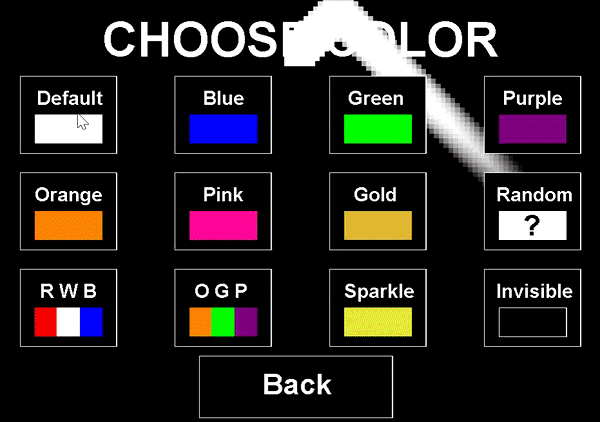Particle
A fast-paced arcade-style game that challenges the player's ability to react quickly to avoid enemies. Including Easy, Normal, and Hard difficulties, Particle is designed for players of all abilities.
Inspiration & Foundation
 After finishing my Freshman year Data Structures and Program Design
class midst the Coronavirus epidemic, I was inspired to challenge my
capabilities by creating a fully functioning Java game. At this
point the "games" I have created only used the output window of the
IDE because my classes never required anything like a JFrame or
frame rates. I fully depended on RealTutsGML's series "Let's Build a
Game in Java" to provide me with a basis for a game idea and the
fundamentals of game design. I took his concept game originally
called "Wave" and expanded upon it. The original Wave game in the
tutorial, which is completely included in my game, includes a menu
system, player control via key input, a few basic enemies, a red
boss enemy, and many other concepts and ideas.
After finishing my Freshman year Data Structures and Program Design
class midst the Coronavirus epidemic, I was inspired to challenge my
capabilities by creating a fully functioning Java game. At this
point the "games" I have created only used the output window of the
IDE because my classes never required anything like a JFrame or
frame rates. I fully depended on RealTutsGML's series "Let's Build a
Game in Java" to provide me with a basis for a game idea and the
fundamentals of game design. I took his concept game originally
called "Wave" and expanded upon it. The original Wave game in the
tutorial, which is completely included in my game, includes a menu
system, player control via key input, a few basic enemies, a red
boss enemy, and many other concepts and ideas.
The Basics
The player is a default white square that must dodge oncoming square
enemies and bosses to avoid losing health. The player, enemies, and
bosses have "trails" that make the experience visually attractive
but do not have effect on actual gameplay or hitboxes. In normal and
easy mode, the player can utilize a shop were they spend money
(earned by staying on the screen over time) for health upgrades,
speed upgrades, and health refills. The player
 loses the game when their health bar is empty, and they win by
surviving past all of the enemies, resulting in a congratulations
visual. The concept of creating this gameplay initially blew my mind
but after following the YouTube tutorial, I understand its
simplicity. The game algorithm updates the screen of the game 60
frames per second (FPS). The fillRect() method of the Graphics class
in Java simply draws a solid rectangle with a designated size at a
desired location. The rectangle appears to move because my code will
draw the same rectangle 5 pixels in the corresponding direction the
player inputs. 5 pixels is a small distance, but since the game runs
60 FPS, the player moves 300 pixels a second or about half the
screen--making the game fast paced. All of the enemies and bosses
follow this concept but follow directions within the code or as
reactions to the player's position.
loses the game when their health bar is empty, and they win by
surviving past all of the enemies, resulting in a congratulations
visual. The concept of creating this gameplay initially blew my mind
but after following the YouTube tutorial, I understand its
simplicity. The game algorithm updates the screen of the game 60
frames per second (FPS). The fillRect() method of the Graphics class
in Java simply draws a solid rectangle with a designated size at a
desired location. The rectangle appears to move because my code will
draw the same rectangle 5 pixels in the corresponding direction the
player inputs. 5 pixels is a small distance, but since the game runs
60 FPS, the player moves 300 pixels a second or about half the
screen--making the game fast paced. All of the enemies and bosses
follow this concept but follow directions within the code or as
reactions to the player's position.
Difficulty Choices
 Particle contains three difficulty options to choose from to make
the game enjoyable for all players. I designed the Normal difficulty
first because at the time I did not have intention for more
difficulties. Normal difficulty has the player start with a speed of
5 pixels per frame, allows access to the shop, and moderately spawns
enemies. The tutorial I followed showed how to make a Hard
difficulty, but I made many modifications to its suggestions. The
Hard difficulty has the player move 7 pixels per frame, does not
allow access to the shop, doubles the amount of initial health, and
has greater spawn rate of more difficult enemies. In the easy
difficulty, there is access to the shop, the normal amount of
health, and a low spawn rate of enemies.
Particle contains three difficulty options to choose from to make
the game enjoyable for all players. I designed the Normal difficulty
first because at the time I did not have intention for more
difficulties. Normal difficulty has the player start with a speed of
5 pixels per frame, allows access to the shop, and moderately spawns
enemies. The tutorial I followed showed how to make a Hard
difficulty, but I made many modifications to its suggestions. The
Hard difficulty has the player move 7 pixels per frame, does not
allow access to the shop, doubles the amount of initial health, and
has greater spawn rate of more difficult enemies. In the easy
difficulty, there is access to the shop, the normal amount of
health, and a low spawn rate of enemies.
Color Menu
One of the most challenging aspects that I purely created on my own
was the color menu of the game. The color menu allows the player to
choose from a variety of colors to change the color of their player
to what ever they may like. There are standard color options such as blue and pink, but the
color menu includes some interesting and fun choices to make
gameplay visually exciting. The random selection will generate a
random color from over 16 million different colors, the rwb and ogp
options generate a stream of alternating through the three
respective colors, the sparkle color goes randomly through a stream
of the 16 million colors, and the invisible option is simply colored
black to challenge the player matching the background (I can attest
that it is possible to beat the game invisible in easy mode). I am
proud of the visual of the menu itself as the player in the back
matches the color of the selected option, which can be fun to play
with.
There are standard color options such as blue and pink, but the
color menu includes some interesting and fun choices to make
gameplay visually exciting. The random selection will generate a
random color from over 16 million different colors, the rwb and ogp
options generate a stream of alternating through the three
respective colors, the sparkle color goes randomly through a stream
of the 16 million colors, and the invisible option is simply colored
black to challenge the player matching the background (I can attest
that it is possible to beat the game invisible in easy mode). I am
proud of the visual of the menu itself as the player in the back
matches the color of the selected option, which can be fun to play
with.
Closing Comments
Particle is completely free to play, so please use the download link to try out the game for yourself! The download link will download a JAR file which requires you to have the current version of Java installed on your computer. Please note that I have had issues with the JAR file running on Apple computers. Windows 10 will show a warning about harming your computer, but I promise you it will not harm your computer whatsoever (It only shows that warning because it does not recognize my signature). I have also implement an online version of the game, but due to Google Chrome's security restrictions and dropped support of applets, I could only get the game to run via Repl.it. This is the only safe and free way I was able to implement my game to my website. Unfortunately, this online JDE is extremely slow and laggy, so the gameplay experience is nowhere near ideal. Sorry for the inconvenience, but it is the best I can do so far. I would love to hear from you and your experience, so I encourage to contact me via my social links and email provided. Please know that Particle or Bianucci Games is not trademarked in any way and does not have any intentional copyright infringement, that being said, please contact me via email to resolve any issues, and I will be quick to make appropriate changes. Particle was made to allow myself to expand my programming knowledge, and educate and entertain those that play the game.
Having issues with the game?
Try refreshing the page, click the
stop button then the play button, or click on "open in repl.it".